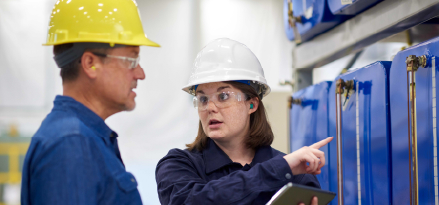By Tom Schiff, Global Field Engineering Support Manager, ExxonMobil Fuels & Lubricants
Safety has long been a core value for most industrial companies, and with good reason.
Implementing safety best practices helps reduce employee risk, which in turn helps minimize the number of workplace accidents and ensure compliance with industry and governmental regulations.
However, the most successful companies also know that embracing safety can have a meaningful impact on another key success factor – their bottom line.
Workplace accidents are costly. According to the National Safety Council, the true cost of work-related injuries in the United States – which includes administrative expenses, medical costs, and wage/productivity losses – topped $180 billion in 2013 alone.i
Minimizing these costs not only relies on developing a robust safety program, but also, more importantly, on creating a culture of safety that permeates the entire organization – from the executive suite to the plant floor.
Let’s take a look at some of the key guidelines that can help you build a culture of safety at your organization.
Leaders create the culture
Instilling a strong safety culture starts with leadership. Leaders set the tone for their business, and this includes attitudes towards safety.
More specifically, leaders must take initiative in encouraging employees to own the system and fully believe in it. In doing so, employee behaviors and beliefs can start to change, thus helping your organization achieve a sustainable safety mentality.
At ExxonMobil, for example, safety is a theme that’s discussed extensively among the company’s leadership. Employees are constantly reminded how safety is core to the company’s identity, and executives continue to champion new programs at industrial sites and within corporate campuses that improve safety best practices.
These programs have worked because the company’s leaders themselves participated in and advocated for all of these initiatives. If you want others within your organization to embrace the right safety behaviors, look to your leadership.
Safety is an ongoing journey
Achieving a best-in-class safety culture does not happen overnight, it demands a philosophy of continuous improvement.
As soon as you make the decision to reinforce safety at all levels of the organization, you can make immediate gains by taking advantage of the low-hanging fruit, such as outfitting employees with the right safety gear, clearly identifying hazard areas, providing safety training and deploying mitigating actions.
But, you must continue to build on these quick wins by implementing tools, processes, and behavior-based programs that enforce or facilitate safety best practices. These include avoiding distractions while driving or walking safe behavior observations, assessment protocols and feedback mechanisms.
Your company can also look to implement more in-depth safety programs and comprehensive safety training, such as a Job Safety Analysis (JSA) or a Personal Safety Leadership Plan. These plans allow employees to determine the safest means of doing their job, enabling the organization to analyze and mitigate risks in a timely and efficient manner.
Over the long term, continue to measure the success of these safety programs to identify opportunities for further improvement.
Partner with companies that also prioritize safety values
Any company that wants to build a culture of safety should also expect that same philosophy from their business partners.
Take a partner like your lubricant supplier. Typically, these partners are viewed primarily as vendors whose impact on your organization ends with the transfer of products bought or services rendered.
However, these partners can play an important role in helping reinforce a strong safety culture. They can help you reach your goals by ensuring the manufacture and distribution of lubricants in a safe manner, keeping safe while on customer sites, and lending their expertise to help bolster your operation.
The right lubricant technologies and technical service offerings can help optimize the performance of your equipment, meaning reduced human exposure to machinery. For example, equipment reliability studies and lubricant reclamation programs help reduce mean time between failures or repairs, helping further minimize safety risks associated with maintenance-related human-machine interaction.
The importance of selecting the right partners extends beyond just lubricant suppliers, and you should vet each business partner to make sure they adhere to the same safety standards you expect throughout your own organization.
Building a strong safety culture is a slow process, but following these guidelines can help ensure you make efficient progress and achieve your long-term goals.
ihttp://blog.nsc.org/true-cost-of-workplace-injuries-infographic



